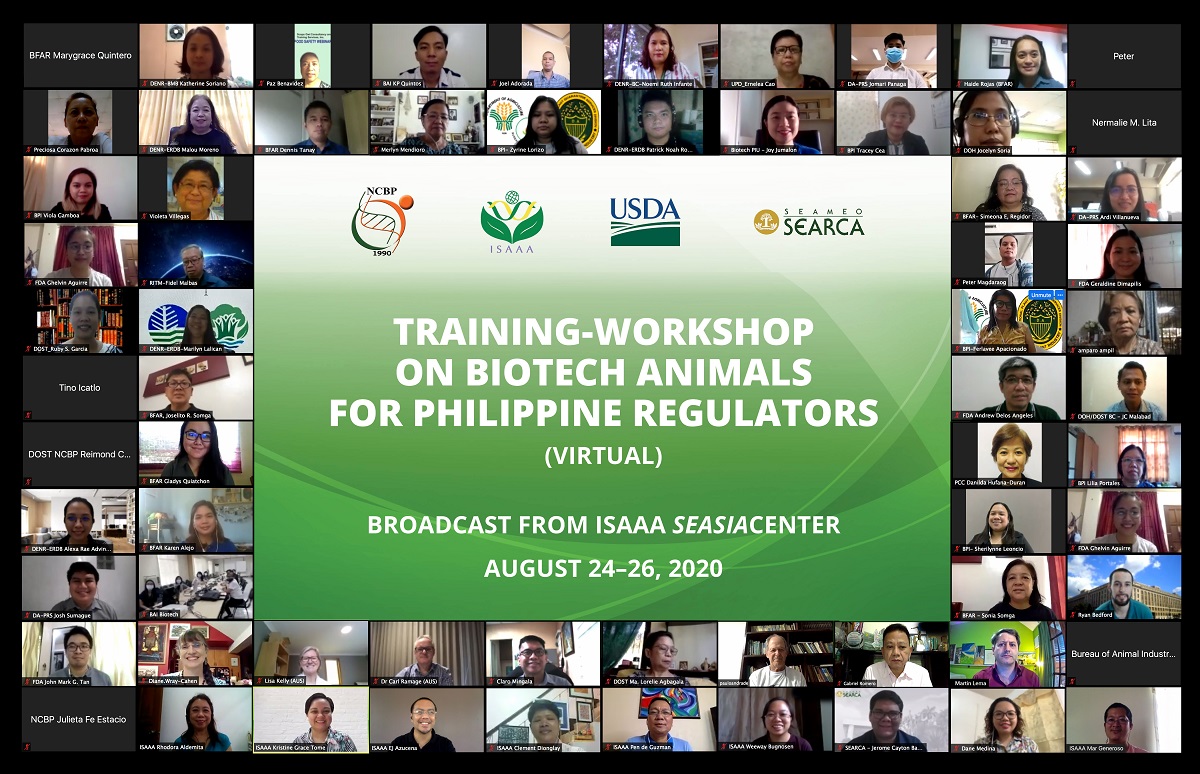Technical Experts Shape Up Philippines’ Regulatory Framework for Animal Biotechnology
| |

Filipino technical experts from various government agencies have come together for a three-day virtual training-workshop, Training-Workshop on Biotech Animals for Philippine Regulators, broadcasted from ISAAA SEAsiaCenter from August 24 to 26, 2020. Dr. Rhodora R. Aldemita, director of ISAAA SEAsiaCenter welcomed the participants to the activity that is aimed to improve the current draft of the Philippine regulations on animal biotechnology and review the regulatory agencies’ capabilities in handling products derived from animal biotechnology. The activity was planned for face-to-face engagement but was held as an online workshop due to the limitation of the pandemic.
More than 70 representatives from the Departments of Agriculture (DA), Science and Technology (DOST), Environment and Natural Resources (DENR), and Health (DOH) participated in the online workshop hosted by the International Service for the Acquisition of Agri-biotech Applications (ISAAA) in collaboration with the DOST-National Committee on Biosafety of the Philippines (DOST-NCBP), the Southeast Asian Regional Center for Graduate Study and Research in Agriculture (SEARCA), and the United States Department of Agriculture (USDA). Experts from the Philippines as well as from Argentina, Australia, Brazil, and the United States were invited to discuss their respective country’s experiences in developing and regulating genetically modified (GM) and gene-edited (GEd) animals, as well as give an overview of their own country’s animal biotech regulations.
One of the highlights of the training-workshop was the thorough assessment of the draft Philippine regulatory framework for animal biotechnology. The participants were divided into several groups with representatives from the different government agencies involved and reviewed a particular section of the guidelines. With the help of the international resource persons who cited the experiences that other countries have gone through to develop and import biotech animals, the groups were able to come up with the improved section guidelines Group outputs were presented to everyone followed by a detailed discussion led by Dr. Claro Mingala, Head of the Animal Biotechnology Guideline Drafting Committee. The feat resulted in a complete, inter-agency collaborative review of the Philippine Regulatory Framework for animal biotechnology done in less than a day through a virtual setting that will be considered by the Technical Working Group who wrote the draft.
Also reviewed during the workshop was each department-agency’s capability to regulate, monitor, and conduct activities involving animal biotech products. All department-agencies present in the workshop made an internal assessment of the strengths of their regulatory offices, which included technical knowledge of experts, existing laboratories and facilities, and existing mechanisms and rules on how their organization will take on the task of regulating GM and GEd animals. They also identified what the agencies lacked and how to address this to become fully capable of handling GM and GEd animals, which includes terrestrial farming land animals, aquatic animals, arthropods, and other GM and GEd animals that may need regulating in the future. The recommendations from these assessments will be handed to the central committee overseeing the drafting of the guidelines to make sure that all regulatory agencies are technically equipped before putting the framework into place.
Some of the takeaway messages at the end of the workshop included that the Filipino regulators need to clearly establish the definitions that will be put in the guidelines. “Definitions are critical,” according to Dr. Lisa Kelly of the Food Standards Australia New Zealand (FSANZ). “Pick definitions that will give you longevity into the future and the flexibility you need to deal with future products. Take a more principle-based approach to regulation because this is important for flexibility,” she added. “The guidelines should be applicable to multiple fields. They should be flexible and able to accommodate new technologies in fifteen to twenty years' time,” said Dr. Carl Ramage of Rautaki Solutions Pty. Ltd. in Australia. Dr. Kelly also reminded the participants to draw their experiences from regulating GM plants, “Don’t reinvent the wheel. There is a lot that can be adapted from the plant biotech regulations and these can be adapted to suit animals,” she said. “Keep an eye on your regulation for GM plants to have a minimum level of coherence between plants and animals,” Dr. Martin Lema of the University of Quilmes in Argentina said. He emphasized that this was to avoid claims that the two regulated materials are being treated differently. Dr. Paulo Paes de Andrade of the Federal University of Pernambuco in Brazil reminded the participants about the importance of risk assessment in the regulation of GM products. “Risk assessment is fundamental and central in regulation,” he said. Moreover, all the invited international experts encouraged the Filipino regulators to look into the experiences of different countries who already have animal biotech guidelines in place and to make use of existing international guidelines when finalizing the framework for the Philippines.
Dr. Mingala addressed the participants that future consultations will follow the completed workshop in order to have a good regulatory policy that the Philippine government can use for all the industries involved. Dr. Diane Wray-Cahen of USDA added, “This leads to further engagement and the continued dialogue helps facilitate the development of effective regulatory approaches for products of animal biotechnology in the Philippines. These approaches will stimulate domestic innovation and allow Filipino farmers access to a diversity of animals that are improved using biotechnology. We need to think ahead about what may be coming so that we are better prepared to meet future challenges.”
| Newer Post | Archive | Older Post |
Science Speaks is ISAAA Inc.'s official blog. Weekly blog articles, authored by ISAAA writers, partners, and invited contributors, aim to help share, disseminate, and promote scientific knowledge and its vital role in achieving global agricultural sustainability and development. Your support to Science Speaks will help us achieve this goal. You can help us by donating as little as $10.

